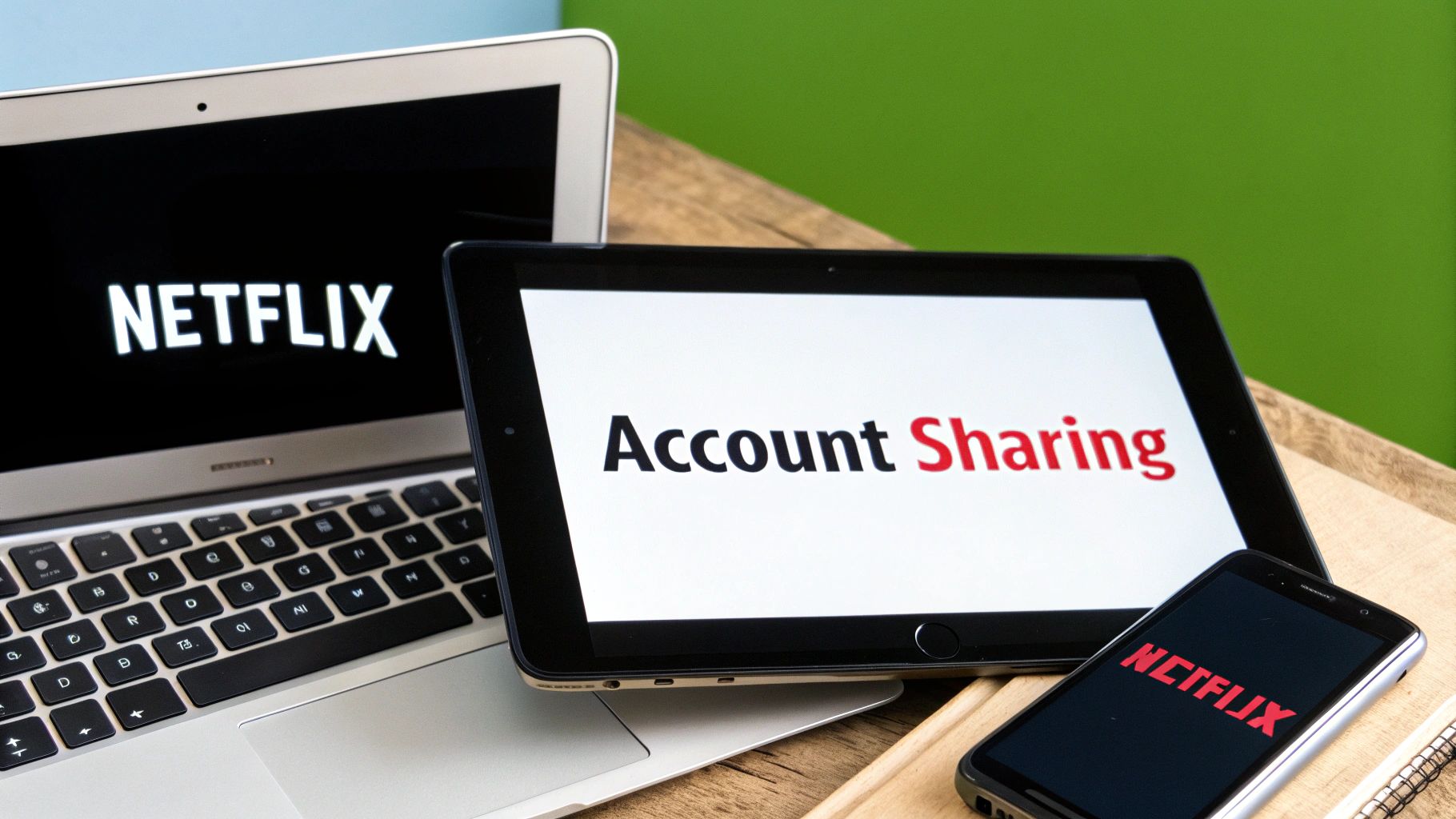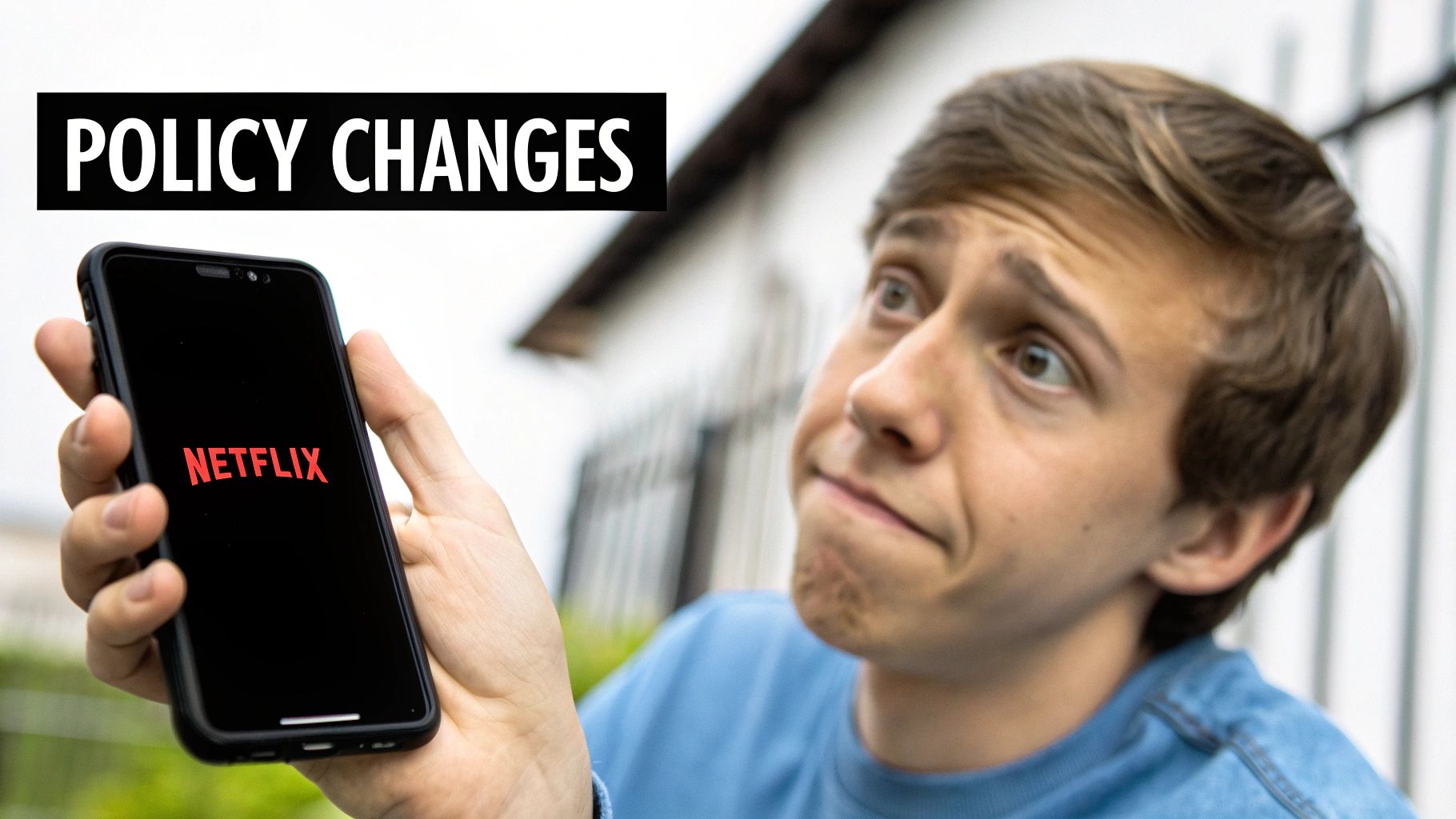
The Ultimate Guide to Netflix Account Sharing: Navigating the New Streaming Landscape
Share
The Evolution of Netflix Account Sharing: From Cultural Phenomenon to Policy Shift

Netflix password sharing started as a simple way for friends and family to split the cost of entertainment. In its early days, sharing login details was as normal as lending someone a DVD. This casual approach helped Netflix grow quickly and become a household name in streaming entertainment.
The Initial Embrace of Sharing
Netflix's early stance on password sharing was notably relaxed. The company saw how shared accounts helped create buzz around their shows and brought new viewers to the platform. When friends and family watched together, even from different locations, it created a sense of connection. Many of these password borrowers later became paying subscribers after experiencing the service firsthand.
The Shift Towards Stricter Policies
As competition grew fiercer in the streaming world, Netflix began looking more closely at account sharing. The rising costs of creating original content and pressure from investors pushed the company to address this revenue gap. Studies showed that roughly 100 million users worldwide accessed Netflix without paying, including 30 million in the U.S. and Canada. After Netflix started enforcing stricter rules in May 2023, the percentage of U.S. adults borrowing accounts dropped from 15% to 10% by 2024. Learn more about these trends from Stream TV Insider's research.
Navigating the Changing Landscape
Netflix's tough stance on password sharing marks a key shift in streaming history. Other services are now following suit, reconsidering their own sharing policies. Users have responded in different ways - some have signed up for their own accounts, while others explore sharing options within the new rules or switch to different services. These changes show how streaming companies must balance customer satisfaction with business growth.
Understanding Netflix's New Sharing Policies: A Comprehensive Guide

Netflix has updated its account sharing rules with important changes that affect all subscribers. Let's break down these new policies so you can understand how to properly share your account with family and friends.
Defining a Netflix Household
The foundation of Netflix's updated policy centers on the concept of a Netflix Household. This refers to people who live together at the same physical address. Your household is linked to your home internet connection and the devices you regularly use there. According to the new terms, sharing access with people outside your household is not allowed.
Verification and Location Tracking
To enforce these rules, Netflix uses several verification methods including:
- IP address monitoring
- Device ID tracking
- Account activity analysis
Regular streaming from your home helps establish your devices as part of your household. This can create some challenges when traveling, which we'll explore below.
Permitted vs. Restricted Sharing
You can freely share your account with family members living in your home by creating individual profiles. However, sharing with friends or relatives at different addresses is now limited. To address this, Netflix offers two main options:
- Transfer Profile: Move your profile to a new membership
- Extra Member: Add someone outside your home for $7.99 monthly
These changes have proven successful - Netflix gained 9.33 million new paid subscribers in Q1 2024, reaching a total of 269.60 million subscribers. Learn more about the impact of these policies in this detailed analysis from Nerdist.
Managing Your Netflix Account for Sharing
Following these guidelines helps you avoid account suspension while sharing Netflix legally within your household. Proper management ensures everyone maintains access while staying within Netflix's terms of service. You might be interested in: How to master sitemap pages.
The Business Impact: Understanding Netflix's Financial Transformation

When Netflix changed its account sharing rules, it wasn't just about stopping password sharing - it was a careful business decision that reshaped how the company makes money. Let's look at what this meant for Netflix's bottom line and its future plans.
Revenue Growth and Profitability
The numbers tell a clear story about how this policy change boosted Netflix's income. In the UK alone, stopping password sharing helped drive record profits of £60.6 million in 2023, up from £34.1 million in 2022. UK revenue grew from £1.54 billion to £1.66 billion in the same period. Looking at global results, Netflix earned $33.7 billion in 2023, marking a six percent increase from 2022, while profits jumped to $5.4 billion from $4.4 billion. Find more details about these financial results in CityAM's coverage. This extra money means Netflix can spend more on new shows and improve its service.
Content Investment and Platform Development
With the added income from its new sharing rules, Netflix can create more original shows and movies. When Netflix makes better content, more people want to subscribe. The company is also using this money to make its streaming platform work better and add new features that viewers want.
Global Strategy and Market Response
Different countries have reacted differently to Netflix's new sharing rules. While some regions quickly accepted the changes, others pushed back more strongly. Netflix has learned it needs to adjust its approach based on local preferences - from pricing to special offers to the types of shows it makes available.
The Future of Streaming Entertainment
Netflix's success with stricter sharing policies has caught other streaming companies' attention. Many are now looking at their own rules about password sharing. These changes could affect how we all watch and pay for streaming entertainment going forward. As platforms try to grow their subscriber base, they'll need to find the right balance between making money and keeping viewers happy.
Beyond Subscriber Numbers: Netflix's New Success Metrics

Netflix's recent changes to account sharing policies have led to a rethinking of how they measure success. The company has moved beyond just tracking total subscribers to look at deeper metrics that show how people actually use and enjoy the service.
From Subscriber Counts to Engagement Analysis
For years, Netflix's main success metric was simple: count paid subscribers. But with shared accounts and different subscription types becoming common, that number alone doesn't tell the full story. The company now focuses heavily on engagement metrics to better understand how viewers interact with their platform.
The Power of Engagement Data
Netflix tracks key data points like watch time, content preferences, and how often users return. They analyze patterns like series completion rates and use of features such as "My List." These insights help Netflix make smarter decisions about new shows and improve user experience. Better understanding of viewing habits also means they can suggest more relevant content to each user.
The company's new approach is already showing results. In Q1 2024, Netflix reported $9.4 billion in revenue (up 15%) and $2.3 billion in net income (up 79%). The company sees engagement as the clearest sign of customer satisfaction and a key predictor of retention. Starting Q1 2025, Netflix will stop reporting quarterly membership numbers, focusing instead on engagement and financial metrics like revenue and operating margin. Learn more about these changes in this Marketing Week article.
Shaping the Future of Content Delivery
These measurement changes matter for both Netflix and its viewers. The focus on engagement drives Netflix to create content that truly connects with audiences. It also encourages a wider variety of shows and movies to match different viewer interests. Success now depends less on subscriber numbers and more on creating an experience that keeps people watching and coming back for more.
Maximizing Value: Smart Strategies for Legal Account Sharing
The rules for sharing Netflix accounts have been updated. To keep enjoying the service properly, you'll need to understand the new guidelines. Let's explore practical ways to get the most value from your Netflix subscription while following the official policies.
Choosing the Right Netflix Plan
The foundation of smart Netflix sharing starts with picking the right subscription tier. The key differences between plans are video quality and how many people can watch at once. A Standard plan with HD streaming and two simultaneous screens works well for smaller households. If you have more family members, the Premium plan offering Ultra HD and four concurrent streams might be worth the upgrade. Take time to evaluate your actual usage patterns to avoid paying for features you don't need.
Mastering Profile Transfers and Extra Members
Netflix provides tools to help users navigate the new sharing framework. The Profile Transfer feature helps people maintain their viewing preferences when creating their own account - perfect for someone moving out who wants to keep their watchlist and recommendations. For sharing beyond your household, the Extra Member add-on lets you officially include other users for an additional cost. Check out our guide on managing your Netflix sitemap for more details.
Practical Sharing Solutions for Different Households
Every family situation is unique when it comes to Netflix sharing. College students away from home can stay connected through the Extra Member option. The same works for couples living separately who want to share an account legally. The key is finding an approach that matches your specific circumstances while following Netflix's household-based policies.
Optimizing Your Shared Netflix Experience
Good profile management makes sharing Netflix smoother, even within one home. Each person should have their own profile to get personalized show suggestions. This keeps kids' cartoons from mixing with grown-up recommendations. Being mindful of how many people can watch at once under your plan helps prevent viewing disruptions. Setting basic ground rules about peak watching times can reduce conflicts over screen access.
By following these guidelines thoughtfully, you can maximize your Netflix subscription's value while staying within the service's rules. Making informed choices about your plan and using the available features effectively leads to better streaming for everyone involved.
The Future of Streaming: Where Account Sharing Is Headed
The shift in Netflix's account sharing rules has created significant changes across streaming platforms. Other services are watching closely and adjusting their own approaches. But what will account sharing look like in the coming years, and how will these changes impact our viewing habits?
How Netflix's Changes Impact Other Services
As the leading streaming platform, Netflix's policy updates tend to influence industry standards. After Netflix introduced stricter sharing rules, other platforms began reviewing their own policies. Many services are testing new verification systems and exploring pricing models that promote individual subscriptions. This points to a broader industry shift toward more controlled account access.
New Tech Solutions for Sharing
Account security is getting smarter through technology. Biometric login systems using fingerprints or facial recognition could make it easier to manage who can access accounts. These tools would help families share accounts while preventing unauthorized usage.
Fresh Takes on Subscriptions
Streaming services might introduce more flexible payment options. Think usage-based pricing that changes with the number of viewers, or enhanced family plans with clear sharing guidelines. Users could pick cheaper single-stream options or pay more to share with extended family. Some platforms already offer group discounts for multiple users.
Policy Changes on the Horizon
Government oversight could shape how we share accounts in the future. Different countries may create rules about account sharing to protect users or support their media industries. Understanding these upcoming changes will help viewers plan ahead.
Making Sharing Work Better for Everyone
As viewers expect more personal experiences, streaming platforms need to balance security with convenience. Profile features within shared accounts may expand to give users better control over their watchlists and viewing history. These improvements can make sharing work better for everyone involved.
For a practical solution to manage your subscriptions today, check out AccountShare. This platform helps groups save money by sharing the cost of premium services together. AccountShare makes it simple to access the content you want without overpaying. Learn more at AccountShare's website.
